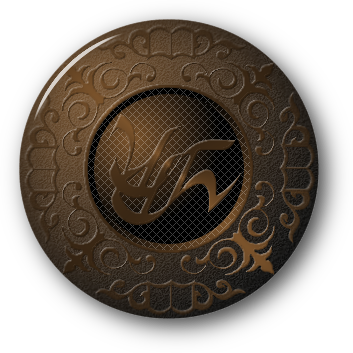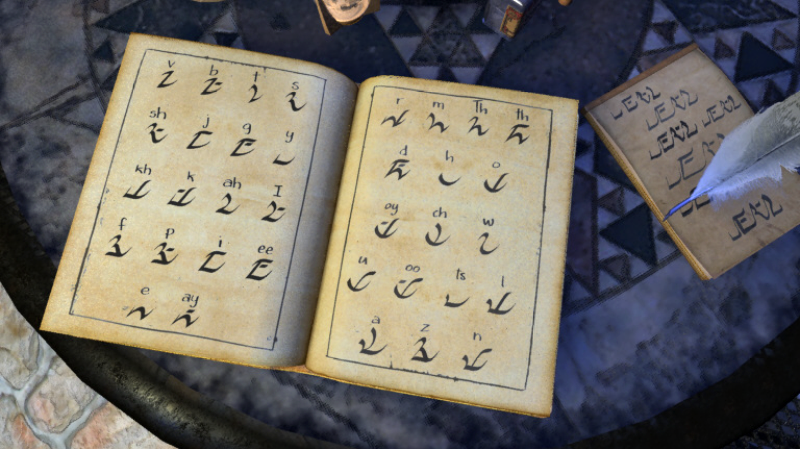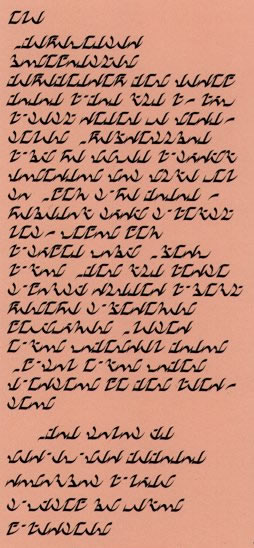

|
|
This is a basic guide to D'ni writing. D'ni characters for writing were very different from our own, although they did have some similarities. D'ni wrote horizontally from left to right, in the same fashion as European languages. As with European writing, each character denotes a single sound. Numbers had places from right to left, the same way as the Arabic-dirived numerals used around the world today. Cyan's mode of rendering D'ni into Roman letters varies according from source to source, but is always based on an attempt to use conventions that are familiar to English speakers. This dictionary uses the most common of the methods, and uses it consistently for all words transcribed from words published in the D'ni script. However, there are times (usually in examples) when words will use the transliteration style that Cyan used for that word or phrase. There is a direct corelation between D'ni letters and numbers. The letters are variations of the same shapes used for the numbers. Diacritic marks created by adding an apostrophe over the letter bases are used to create variations. In this chart, the pronunciation is shown in the darker boxes, the D'ni numerals are shown below the arabic ones, and the keystroke for D'nifont is shown below the D'ni letter. The D'ni numbers and letters are shown next to each other to ease comparison to see how they are shaped similarly. As you can see from this, D'ni alphabetical order is based on the letters' numeric values from one through twenty-four.
Several of the following tables were originally designed by Jehon, and have been adapted for this site.
Note that Cyan uses I and ai for the letter represented here by í, frequently uses e for eh, and a for ah, and occasionally uses ay for ai, u for uh, oi for oy, and e for ee. In proper names (D'ni, Rakeri, etcetera) the final i is often, but not always, used for ee. Other variations will also be found in use among students of the language and writing of the D'ni. There is no fixed standard of transliteration because the D'ni never had any contact with surface cultures that use the Roman Alphabet. Since the rediscovery of D'ni, various scholars in our societies have created their own individual systems for their work, and little attempt has been made to standardize them. If you want to know the system Anna used to teach Atrus, and later that Atrus and Katran taught Yeesha when she was young, that is known because one of Yeesha's schoolbooks has been photographed. In this picture, we see Yeesha's schoolbook open to two pages of D'ni letters, with their Roman equivalents above them in a smaller font. To the right is a notepad where Yeesha had been practicing writing her name.
The values are based on inferences from the text. Words that (if read according to the published values used in other texts) would appear quite unfamiliar, such as nirkhchivon, yiv cheh, ch'gehschoy, b'fisī, or g'aehv i'shehn, become sensible when the proposed substitutions are made. We get mahrntahvom ‘your creation', tsahv teh ‘I live in', t'gehstoy ‘by art', b'fahsee ‘entirely' (‘to twenty-five'), and g'chehv ah'shehm ‘and I thank you'. An explanation of this variant D'ni alphabet has not been forthcoming. But the fact that it employs fewer symbols, that some of the differences seem to preserve a similarity of shape, and that it is used for the writing of a prayer, all tend to suggest that this may be an archaic variant of D'ni writing. Perhaps this version predates the systematic association between the letter-forms and the numerals, which might very well have led to the addition of a few forms (to fill in gaps) or a reassignment of values to make it easier to distinguish similar forms based on their context. Typing D'ni Letters Cyan Worlds has a D'ni TrueType font pack available called rcd_fonts. It has two fonts, Dn______.TTF (DniFont) and SILDIPAR.TTF. The second font is a character set that types variant characters in Roman script. This table includes a column that shows the English keyboard keys to type DniFont characters. You can download rcd_fonts here. By referencing this table, you can create your own D'ni messages that can be seen by anyone else with the fonts installed, or use the font in any image editor to add D'ni script to any picture.
|
|||||||||||||||||||||||||||||||||||||||||||||||||||||||||||||||||||||||||||||||||||||||||||||||||||||||||||||||||||||||||||||||||||||||||||||||||||||||||||||||||||||||||||||||||||||||||||||||||||||||||||||||||||||||||||||||||||||||||||||||||||||||||||||||||||||||||||||||||||||||||||||||||||||||||||||||||||||||||||||||||||||||||||||||||||||||||||||||||||||||||||||||||||||||||||||||||||||||||||||||||||||||||||||||||||||||||||||||||||||||||||||||||||||||||||||||||||||||||||||||||||||||||||||||||||||||||||||||||||||||||||
Myst, the Myst logo, and all games and books in the Myst series are registered trademarks and copyrights of Cyan Worlds, Inc. Myst Online: Uru Live is the sole property of Cyan Worlds Inc. The concepts, settings, characters, art, and situations of the Myst series of games and books are copyright Cyan Worlds, Inc. with all rights reserved. I make no claims to any such rights or to the intellectual properties of Cyan Worlds; nor do I intend to profit financially from their work. This web site is a fan work, and is meant solely for the amusement of myself and other fans of the Myst series of games and books. |

 The text of Atrus's Prayer in the 1996 Myst Calendar has a different assignment of phonetic values to some of the characters, and a few others do not appear. The following tables chart the sounds that are used.
The text of Atrus's Prayer in the 1996 Myst Calendar has a different assignment of phonetic values to some of the characters, and a few others do not appear. The following tables chart the sounds that are used.